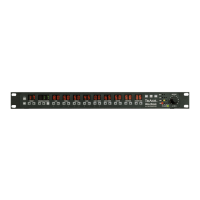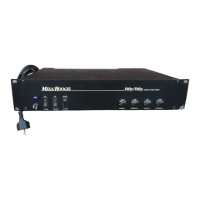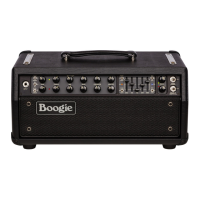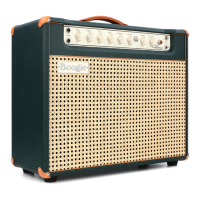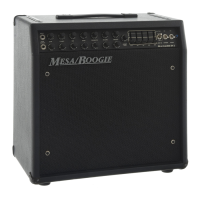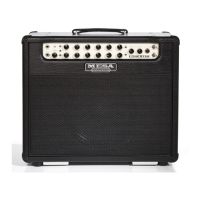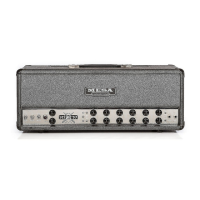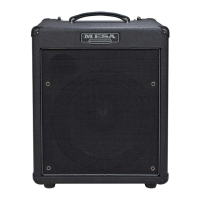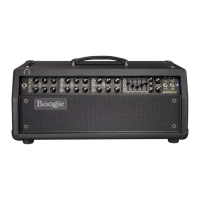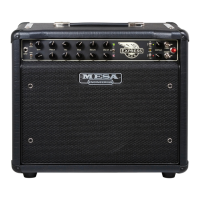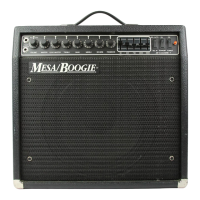acter that has more dynamic content available. This region is great for clean, sparkling chording in Channel 1, where the maximum
headroom is available, the top end harmonics are bubbly and the attack is lightning fast. Channel’s 2 and 3 are tuned to deliver
threshold sounds in this zone where the gain is warm and furry, but there is still plenty of the guitar’s personality intact. This zone
is great for all the Channel 2 sounds when used for clipped chording, as there is plenty of dynamics intact that have not yet been
compressed by too much saturation.
The middle region of the GAIN control (11:00 – 2:00) is where the most balanced sounds live and you will find this region delivers
warm, full sound, detailed attack and good dynamics and the Tone controls still have a powerful effect on the signal. Channel 1 CLEAN
delivers great chording response, sounds richer and has more body here. Depending on pickup style and strength you will have to
watch for clipping as you are nearing the crossover point - gain-wise. Some of Channel 2’s best sounds are to be found here as things
start smearing nicely as they start getting into tube overdrive. As you approach 12:00 in Channel 3 there will be plenty of saturation to
keep chords grinding and single notes hanging – but not too much to start compressing the life out of the sound. If you aren’t getting
great results in this region for your gain sounds in Channel 3, you may want to look at trying some pickups with a bit hotter output.
The highest region of the GAIN control (2:00 – 5:00) is all about saturation, especially in Channel 3. Up here the signal gets much
fatter in the low end and the top end begins to recede to create a round, compressed sound. Dynamics become slower with lower
peaks and a more legato, creamier feel is produced. In Channel 1 the high end of the GAIN control produces some great “clipped
clean” sounds as the Input stage gives it up and starts to saturate.
Channel 3 gets truly wild at the top end of the GAIN control and both gain Channels unveil their true potential for soloing. There is
ample gain up here to rip into any style you wish with the Channel 3 pumping out ridiculous levels of thick creamy overdrive for single
notes. With the GAIN maxed you can achieve virtually infinite sustain… if you can keep your guitar stable and from feeding back.
At the highest GAIN settings you will notice the Tone controls have a diminished effect on the sound. The notes are so saturated and
their character has been pre-determined by the way each Channel is voiced and how it reacts to this level of gain. May we humbly
suggest using the GAIN control in its middle range whenever possible to achieve the best balance of overdrive and still retain the full
shaping power of the Tone Controls. Also, your attack will remain definitive and focused in the middle range and not get over saturated
and “slowed down” as it can in the highest region of GAIN settings.
MASTER
This control determines the overall output level of each Channel and is located at the very end of the preamp. By
using it in combination with the GAIN control, any amount of preamp signal strength – gain – (Within a Channel’s parameters) can be
achieved at any playing volume. Once you have dedicated the Channels to their respective sounds, you can then balance the volume
levels of the Channels using the MASTER controls.
In addition to adjusting the playing loudness of the Channels, the MASTER functions as an EFFECTS SEND control for the EFX
LOOP when the LOOP is activated (by connecting plugs to the LOOP SEND and RETURN jacks).
For general applications and to get the best performance out of all the Channels we recommend MASTER settings in the 9:00 – 12:00
range with most people settling in around 10:00 – 11:00 for average playing volumes.
Some purists like to run the MASTER all the way up and raise the GAIN until they reach their desired sound–the thinking there is that
this achieves the purest sound. In theory, they believe this resembles removing the control altogether from the signal path, and in a
way it does. However, most all the “vintage non-master” amplifiers they are seeking to emulate have discrete resistors in that place
in the circuit anyway to adjust or “tune” the output of the preamp to the power section sensitivity.
The MASTER is nothing more than a variable resistor(s) that offers an infinite range of settings possibilities and makes the amplifier
many times more versatile with no sonic penalty. If you prescribe to this old school approach, then by all means, use the Triple Crown
this way… it won’t hurt the amplifier. However you will be severely limiting the potential sounds you can achieve by removing the
limitless great sounding combinations of GAIN and MASTER settings.
PAGE 6
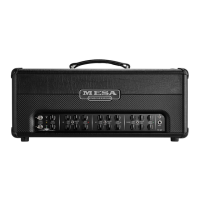
